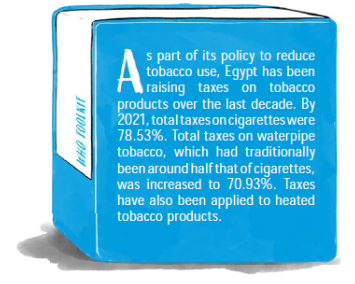World Health Organization
In the words of Tanya Gilly Khailany: “When it comes to women’s rights, there’s no room for diplomacy”
19 Oct 2018
World Health Organization. Regional Office for the Eastern Mediterranean | 12 Sep 2023
Egypt has been making progress in implementing policies that are proven to reduce tobacco use – one of the major risk factors for noncommunicable diseases (NCDs). Given how the country has successfully addressed tobacco use as part of its journey to meeting its 2030 SDG goals, we are therefore putting the spotlight on this aspect of its NCD response in this publication.
 Egypt banned water pipe use in cafes, bolstering the ban with an awareness campaign to debunk the myths surrounding tobacco use and COVID-19.
Egypt banned water pipe use in cafes, bolstering the ban with an awareness campaign to debunk the myths surrounding tobacco use and COVID-19.
Since 1981, Egypt has passed a series of laws to protect people from tobacco smoke at work, on public transport and in public places.
Egypt has been working with WHO and other international organizations to plan and implement changes to the packaging and labelling of tobacco products.
In 2007, Egypt reached the highest level of achievement in monitoring tobacco use and has continued its extensive surveillance programme to inform policies and decision-making.
SHINE – Egypt is one of four countries collaborating on this project researching the challenges of scaling up school-based mental health services. See Pakistan for details.
Reliable data is vital for any country wanting to address tobacco use. The Ministry of Health and Population has collaborated with WHO and the Central Agency for Public Mobilization and Statistics to conduct a range of surveys in Egypt. The data from these surveys has helped to evaluate initiatives, inform policy and assess the need for interventions.
Egypt has conducted the following specialist tobacco surveys:
The Ministry of Health and Population has used Tobacco Questions for Surveys to add internationally standardized questions about tobacco into a wide range of general surveys. This has enabled the Ministry to get an even clearer picture of the landscape of tobacco use in Egypt. Such surveys have included:
This tobacco surveillance programme is ongoing, and Egypt will conduct further Global Youth Tobacco Surveys, as well as monitoring trends in tobacco use, such as electronic nicotine delivery systems.
Egypt’s journey to protect people from tobacco smoke began in 1981, with laws prohibiting smoking on public transport, in open and enclosed public spaces, and in workplaces during work hours. Law Number 4 of 1994 Promulgating the Environment Law reinforced the ban on smoking on public transport and in public places, while laws in 2007 and 2010 expanded the scope of smoke-free areas to settings including health care, places of education and government facilities.
Overall, the Law was not strictly enforced and compliance was low – even in government facilities. However, this is beginning to change and compliance is increasing, especially in health and educational facilities. Also, a 3.8% reduction in tobacco use by young people between 2001 and 2009 suggests a direct impact of the smoke-free policy . Furthermore, the President’s “100 Million Healthy Lives” initiative, launched in 2018, has prioritized NCDs and helped to revitalize Egypt’s efforts to protect its citizens from tobacco smoke.
In Egypt, health warnings on tobacco packaging have had a similar trajectory to the laws protecting people from tobacco smoke. In 1981, the government mandated text-based health warnings occupying at least 30% of tobacco packaging.
These warnings were increased in 2007 to occupy at least 50% of packaging, and Egypt adopted pictorial health warnings in 2008. The implementation of these changes was achieved by collaboration between the Ministry of Finance and the Ministry of Health and Population, as well as collaboration with WHO and other international organizations.
The process is ongoing and is enhanced by Egypt’s advanced tobacco surveillance programme, which allows the Ministry of Health and Population to assess the impacts of awareness campaigns or changes to warnings on packaging .
In March 2020, Egypt banned the use of waterpipes in cafes, with penalties of fines and closures for non-compliance. The Ministries of Health and Population, Local Development and Social Solidarity worked to implement and enforce the ban, supporting it with awareness campaigns.
The Ministry of Health and Population ran a campaign highlighting the link between tobacco use and the transmission of COVID-19 using social media platforms and the Egypt Health Passport mobile application. At the same time, the Ministry disseminated accurate information about COVID-19, which debunked claims that smoking protects people from the effects of the virus. Meanwhile, the Ministry of Social Solidarity collaborated with WHO on a video campaign featuring celebrities explaining the waterpipe ban and the danger of spreading COVID-19.
In January 2021, at the height of the pandemic, Egypt ratified the Protocol to Eliminate Illicit Trade in Tobacco Products. This was a major step in controlling tobacco use and a clear example of the country’s commitment to addressing NCDs by 2030.
This country story is part of a series on sharing successful strategies from the Eastern Mediterranean Region mitigating noncommunicable diseases and mental health disorders during the COVID-19 pandemic and beyond. Discover additional stories and insights in the full report published by the World Health Organization Regional Office for the Eastern Mediterranean.